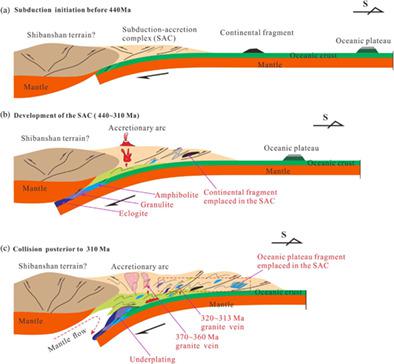当前位置:
X-MOL 学术
›
Geolog. J.
›
论文详情
Our official English website, www.x-mol.net, welcomes your feedback! (Note: you will need to create a separate account there.)
Origins of the meta-mafic rocks in the southern Dunhuang Block (NW China): Implication for tectonic framework of the southernmost Central Asian Orogenic Belt
Geological Journal ( IF 1.8 ) Pub Date : 2021-04-11 , DOI: 10.1002/gj.4144 Mengyan Shi 1 , Quanlin Hou 2 , Chunming Wu 2 , Quanren Yan 2 , Nannan Cheng 1 , Qian W. L. Zhang 2 , Hao Y. C. Wang 3
Geological Journal ( IF 1.8 ) Pub Date : 2021-04-11 , DOI: 10.1002/gj.4144 Mengyan Shi 1 , Quanlin Hou 2 , Chunming Wu 2 , Quanren Yan 2 , Nannan Cheng 1 , Qian W. L. Zhang 2 , Hao Y. C. Wang 3
Affiliation

|
The Central Asian Orogenic Belt (CAOB) is one of the largest accretionary orogenic collages in the world with prominent juvenile crust addition, where the southernmost margin of the CAOB located is one hot topic in the international studies. The Dunhuang Block located to the south of the Beishan Orogen is a key position for outlining the tectonic framework of the south margin of the CAOB. However, at present, the tectonic attribution of the Dunhuang Block is still controversial. In this paper, we focus on the origins and protoliths of the meta-mafic rocks from the Hongliuxia complex in the southern Dunhuang Block for determining the tectonic attribution of the Dunhuang Block. In the field, the meta-mafic rocks are mainly exposed as tectonic blocks within the metasedimentary rocks displaying the “block-in-matrix” fabrics or as tectonic slices juxtaposed by faults. Geochemically, the meta-mafic rocks could be divided into three groups based on the rare earth elements (REE) and trace elements: the group 1 samples are depleted in the LREE relative to HREE and show flat HREE patterns, similar to the mid-oceanic ridge basalt; the group 2 samples show flat REE patterns without obvious differentiation between the LREE and HREE, like the oceanic plateau basalt; the group 3 samples are enriched in LREE relative to LREE, and have negative Nb, Ta, and Ti anomalies, similar to the island arc basalt. Conclusively, the protoliths of the meta-mafic rocks dominantly belong to the oceanic plate components. They were metamorphosed during Early Silurian to Middle Devonian in different depths of the subduction zone documented in previous studies. So, we suggest the Hongliuxia complex is an exhumed Palaeozoic subduction–accretion complex (SAC) formed during the oceanic plate subduction. This result confirms the Palaeozoic subduction event occurred in the Dunhuang region and indicates that the Dunhuang Block is a Palaeozoic Orogen rather than a part of Precambrian continent block. Considering the regional geology context, we speculate the Dunhuang Orogen belongs to the southernmost margin of the CAOB.
中文翻译:

敦煌地块南部变基性岩成因:对中亚造山带最南端构造格架的启示
中亚造山带(CAOB)是世界上最大的增生造山带之一,幼年地壳添加显着,中亚造山带最南缘所在的区域是国际研究的热点。位于北山造山带南部的敦煌地块是勾画中亚盆地南缘构造格架的关键部位。但目前,敦煌地块的构造归属仍存在争议。在本文中,我们重点研究敦煌地块南部红流峡杂岩变基性岩的成因和原岩,以确定敦煌地块的构造归属。在该领域,变基性岩主要以变质沉积岩内的构造块体形式出露,显示出“块体矩阵”结构,或以断层并列的构造切片形式出露。地球化学上,根据稀土元素(REE)和微量元素可将变镁铁质岩分为三组:第 1 组样品相对于 HREE 贫乏 LREE 并显示平坦的 HREE 模式,类似于大洋中脊玄武岩;第2组样品稀土元素分布平坦,轻稀土和重稀土没有明显区别,如大洋高原玄武岩;第3组样品相对于LREE富集LREE,Nb、Ta、Ti负异常,与岛弧玄武岩相似。综上所述,变基性岩的原岩主要属于大洋板块成分。它们在早志留世至中泥盆世期间在先前研究记录的俯冲带的不同深度发生变质。因此,我们认为红流峡杂岩是在大洋板块俯冲过程中形成的古生代俯冲-增生杂岩(SAC)。这一结果证实了敦煌地区发生了古生代俯冲事件,表明敦煌地块是古生代造山带,而不是前寒武纪陆块的一部分。考虑到区域地质背景,我们推测敦煌造山带属于中亚盆地最南缘。这一结果证实了敦煌地区发生了古生代俯冲事件,表明敦煌地块是古生代造山带,而不是前寒武纪陆块的一部分。考虑到区域地质背景,我们推测敦煌造山带属于中亚盆地最南缘。这一结果证实了敦煌地区发生了古生代俯冲事件,表明敦煌地块是古生代造山带,而不是前寒武纪陆块的一部分。考虑到区域地质背景,我们推测敦煌造山带属于中亚盆地最南缘。
更新日期:2021-04-11
中文翻译:

敦煌地块南部变基性岩成因:对中亚造山带最南端构造格架的启示
中亚造山带(CAOB)是世界上最大的增生造山带之一,幼年地壳添加显着,中亚造山带最南缘所在的区域是国际研究的热点。位于北山造山带南部的敦煌地块是勾画中亚盆地南缘构造格架的关键部位。但目前,敦煌地块的构造归属仍存在争议。在本文中,我们重点研究敦煌地块南部红流峡杂岩变基性岩的成因和原岩,以确定敦煌地块的构造归属。在该领域,变基性岩主要以变质沉积岩内的构造块体形式出露,显示出“块体矩阵”结构,或以断层并列的构造切片形式出露。地球化学上,根据稀土元素(REE)和微量元素可将变镁铁质岩分为三组:第 1 组样品相对于 HREE 贫乏 LREE 并显示平坦的 HREE 模式,类似于大洋中脊玄武岩;第2组样品稀土元素分布平坦,轻稀土和重稀土没有明显区别,如大洋高原玄武岩;第3组样品相对于LREE富集LREE,Nb、Ta、Ti负异常,与岛弧玄武岩相似。综上所述,变基性岩的原岩主要属于大洋板块成分。它们在早志留世至中泥盆世期间在先前研究记录的俯冲带的不同深度发生变质。因此,我们认为红流峡杂岩是在大洋板块俯冲过程中形成的古生代俯冲-增生杂岩(SAC)。这一结果证实了敦煌地区发生了古生代俯冲事件,表明敦煌地块是古生代造山带,而不是前寒武纪陆块的一部分。考虑到区域地质背景,我们推测敦煌造山带属于中亚盆地最南缘。这一结果证实了敦煌地区发生了古生代俯冲事件,表明敦煌地块是古生代造山带,而不是前寒武纪陆块的一部分。考虑到区域地质背景,我们推测敦煌造山带属于中亚盆地最南缘。这一结果证实了敦煌地区发生了古生代俯冲事件,表明敦煌地块是古生代造山带,而不是前寒武纪陆块的一部分。考虑到区域地质背景,我们推测敦煌造山带属于中亚盆地最南缘。



























 京公网安备 11010802027423号
京公网安备 11010802027423号